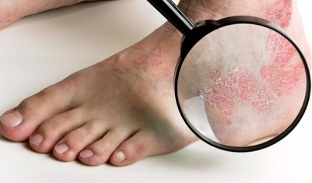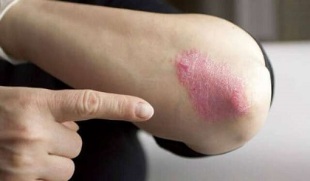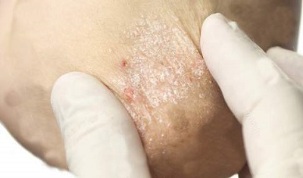Psoriasis is an inflammatory skin disease. Occurs when the immune system fails. The development of the disease is divided into distinct stages-emergence, development, stabilization and regression. The different stages of psoriasis differ in the appearance of spots and rashes, itching and soreness, and extensive skin inflammation.
Why is it necessary to distinguish the development stage of the disease, and what are the characteristics of the course of psoriasis in the early development and recovery process?
Why you need to know the stages of psoriasis

Psoriasis is divided into multiple stages, and doctors can use them to choose the right treatment. The combination of drugs and external preparations prescribed to treat inflammation depends on the stage of development of the disease.
At the beginning of the manifestation of the disease, general therapy is necessary-vitamin complex, diet, external sterile treatment of the rash, for example, UV treatment. Also prescribed drugs that stimulate the intestines, blood vessels, and liver cleansing.
Ensure that the psycho-emotional state is corrected by a neuropathologist or psychologist.
In the initial stage of the disease, they do not use effective drugs that weaken the immune system, nor do they prescribe hormone ointments. These drugs have a large number of side effects, so they can only be prescribed without drugs.
Psoriasis: treatment in acute and remission
In the case of acute progressive disease of the disease, a variety of drugs with different effects are prescribed. Immunosuppressants and glucocorticoids are commonly used to relieve inflammation and reduce itching. External treatment is supplemented by photochemistry, ultrasound and laser treatment. In addition, medicines for the disinfection of damaged skin have been prescribed.
In a stable state, they continue to take anti-inflammatory hormone drugs and gradually reduce the dose. In order to restore damaged skin, ointments with regenerative effects are prescribed.
Relief-support the body. Correct nutrition and take a complex of vitamins and minerals to restore immunity.
Timeliness of treatment
The sooner you start treatment, the easier it will be to control psoriasis.

Timely treatment can limit the spread of skin inflammation, reduce its degree, and prevent subsequent recurrence of peeling. Since psoriasis is often mistaken for an allergic rash at an early stage, it is necessary to know its initial symptoms so as not to miss the appearance of the skin disease.
Note:The doctor is still investigating the cause of psoriasis. However, it is well known that psoriasis inflammation of the skin is not contagious. It cannot be picked up from the patient, nor can it be infected when injured. This is our own failure in the human body.
The cause of psoriasis is immune failure, which may be caused by many factors. Severe stress, poisoning (including potent drugs, industrial waste, alcohol), previous infections.
Psoriasis is difficult to treat. The disease is easy to relapse and relapse. And the treatment itself is symptomatic treatment. It prevents the appearance of new spots and relieves existing skin itching.
Which stage of psoriasis is called the initial stage? How to distinguish early psoriasis and healthy rash? How will the disease develop in the future?
Psoriasis: Early stage
The first appearance of psoriasis on the skin looks like a papule. Most commonly, the rash appears on the bends of the elbows and knees, or where the clothes are pressed tightly on the body (for example, under the belt at the waist). A rash can also appear along the edges of the hair and under the hair, around the nails and on the nail plate. Sometimes psoriasis can occur on the feet and palms.
Psoriasis almost always manifests symmetrically-on the elbows of both hands, the sides of the lower back, or both knees.
In the early stages, the pimples themselves (pimples in medical terms) have a medium appearance. They have:
- pink or red;
- The sharp edges are blurred;
- Small size-papules on the bottom are no more than two millimeters;
- Flat shape-the small punctate papules at the beginning of the disease are hardly raised, so they look like spots.
As the disease progresses, peeling scales will appear on the papules. They are gray or silver, and they look white against the background of red pimples.
The appearance of scales is accompanied by quite severe itching. If you don't resist and scratch, remove the scales, revealing the shiny areas of pink youthful skin underneath. It is very thin, fragile, and prolonged scratching itchy pimples-wounds, bleeding.
The initial stage of psoriasis lasts up to four weeks.
Psoriasis: Progressive stage

In the progressive stage, the various papules merge into a common site, forming so-called psoriasis plaques. They grow above the surface of the skin and are almost completely covered by skin. There is a non-flaking pink-red edge on the edge of the psoriasis plaque.
The presence of edges is an indication of the stage of disease progression. The rim is one to two millimeters wide. The skin is inflamed and resembles parchment in structure.
The edge represents the extended area of the point. This is skin that has been inflamed but has not yet peeled off. After a while, it will also be covered with scales. And the patch will expand to cover the new area of the skin and form a new wider edge.
As the disease progresses, adjacent spots merge with each other. At some point, a large red spot may form on the human body.
The psoriasis plaques are very itchy, giving people an unpleasant feeling, and ruining his work, rest and sleep. They will grow up, occupy a large area, and form a new rash on clean, healthy skin.
The main sign of an advanced stage is the appearance of a new rash. Once new papules and spots appear, the next stage of psoriasis begins-static. This is not a complete victory, but it is already a turning point towards recovery.
In the developmental stage, psoriasis is almost always accompanied by weakness, fatigue, and weakness. Depression is very common. Temperature possible.
Note:Some medical theories are the opposite. Depression is not the result of psoriasis. Psoriasis is the result of neurology and depression.
The progression of psoriasis can last as long as several months.
Psoriasis: stable phase

The main sign of the stationary phase is to stop the appearance of new spots and rashes. At the same time, itching is also reduced and it becomes easier to bear. The rash loses its bright color, changes color, and becomes invisible. This is also one of the signs that the process is stabilizing.
When the inflammation stops spreading, the pink edges around the plaque disappear. Start active exfoliation and healing, regeneration of new healthy skin.
It can be seen to the naked eye that the peeling at the fixed stage has increased. The scales completely cover the entire surface of the psoriasis spots, and there is no space on the rim.
Psoriasis has a typical scaly appearance, which is generally recognized by the public. There is no danger in performing extensive peeling during the fixation phase.
When all the dead cells are shed from the surface of the psoriasis, healthy skin will leave a slight shadow.
Other signs of progress or stability
In addition to the appearance of rashes, spots and scales, there are many other signs that can be used to judge the development of the disease. This is the itch (strong or tolerable), general condition, and the essence of depression. There is also temperature.
In the initial stage, itching is variable and the rash is incomprehensible. In addition, the itching is getting worse every day. In the acute phase of psoriasis, it becomes unbearable. Disrupt sleep, rest, and interfere with work. The person became irritable because the itching sensation did not give him a chance to rest.
In the plateau phase, the itching subsides. Everyday-one feels better. General changes in mental state, negative emotions and depression will weaken. The duration of the fixed phase is a few weeks-from 2 to 5.
Psoriasis is at a decay stage

The fading stage of psoriasis is the almost complete disappearance of plaques, spots, redness, inflammation, and itching.
At this stage of the disease, psoriasis is only reminiscent of different skin pigmentation. In the area of the previous psoriasis spots, it looks lighter. The surface of healthy skin has a darker shade.
In some cases, so-called hyperpigmentation can develop. The skin at the psoriasis spots does not lighten, but darkens. In any case, the difference in skin pigmentation will continue for one to two months.
After recovery from psoriasis: the possibility of recurrence
The possibility of recurrence of psoriasis depends on the person's lifestyle, diet, allergic mood and overall physical condition. It also depends on the toxin content in his body, blood, and liver. If you boost your immune system and cleanse toxins in your liver, blood vessels, and intestines, you can reduce the possibility of repeated skin inflammation.
Psoriasis usually rarely recurs seasonally after washing. A person is still susceptible to illness, but the probability of its occurrence is significantly reduced.
Cleans the body of toxins and takes vitamin and mineral complexes to help strengthen immunity. This is especially important if immunosuppressants are used during the treatment of advanced psoriasis. Their needs are due to the work of inflammatory mediators. After suppressing the autoimmune defenses, it is necessary to restore the immune system.























